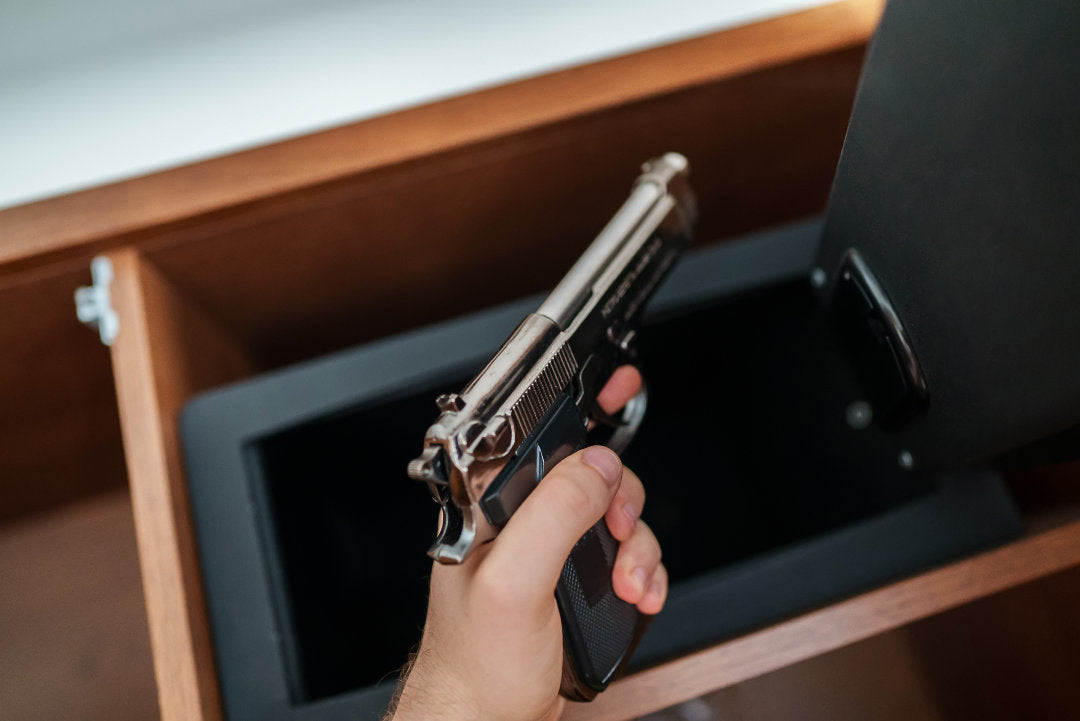Should I Use a Biometric Gun Lock?
- by Casy Smith
-

Jump to:
- How do biometric gun locks work?
- Pros of biometric gun locks
- Cons of biometric gun locks
- Finding the perfect firearm storage solution
As a gun owner, it can be difficult to balance the desire for accessibility and security when picking a gun storage option. With more choices than ever, it’s easy to get overwhelmed by the sheer volume of security mechanisms you can use with your gun safe.
One security method that has exploded in popularity over the last decade is the biometric lock, specifically the fingerprint reader. From phones to credit cards, we have become accustomed to using our fingerprints to secure buildings, electronics, safes, sensitive information and more.
Today, there are many biometric lock gun safes available, but are they the best option for you? Keep reading to learn more about the pros and cons of biometric locks for firearm cases.
How Do Biometric Gun Locks Work?
A biometric lock can include any security system that uses your body’s unique features as a key to unlock. Three common examples of biometrics you may see or use regularly include:
- Fingerprint sensors capture the unique features of your fingerprint and turn them into a digital format.
- Facial recognition scanners analyze your facial features and create a map of your face.
- Voice recognition software detects specific patterns, pitches and inflections in your voice and turns them into usable data points.
While all three of these options can be used for a firearm safe, the most common biometric lock for gun storage is the fingerprint scanner. Two specific types of fingerprint scanners you may see on a gun safe are optical and capacitive scanners.
Optical Sensors
An optical sensor works by taking a picture of the fingerprint with a light source and turning it into a flat digital image. Then, the sensor uses software to detect patterns in the image, map them, and store them. When you place your finger back over this sensor, the lock will determine if it is the correct fingerprint based on the patterns it mapped in the scanning phase.
These scanners are known for their ease of use but can be tricked using a high-quality photo of the fingerprint.
Capacitive Sensors
A capacitive scanner uses several arrays of capacitor circuits that use electrical current to map out a flat fingerprint pattern and detect the depth of the fingerprint ridges, creating a 3D image of the fingerprint. Due to the amount of information recorded, capacitive sensors are considered more secure.
Now that we’ve covered some of the finer details of the fingerprint scanners you may see on a gun safe, let’s review why a biometric gun safe may work for you and why you may want to seek an alternative locking method.
Two Pros of Biometric Gun Locks
There are two significant benefits of using a biometric gun lock:
#1. Biometric Gun Locks Are Convenient
There’s nothing like always having a key with you. With biometric locks, you don’t need to keep or hide a key or remember a passcode. Fingerprint sensor locks only require a quick scan, and you can access your firearm.
#2. Biometric Gun Locks Offer a High Level of Security
The quality of the sensor often determines the level of security. A fingerprint sensor lock from a reputable manufacturer can offer a high level of security as your fingerprint offers a number of unique traits that are difficult to replicate, like a key or passcode.
Two Cons of Biometric Gun Locks
While there are some great benefits to a biometric lock, there are also some downsides that you should consider before making your final purchase:
#1. Biometric Gun Lock Sensors May Not Properly Read Your Fingerprint
While a fingerprint sensor should quickly unlock your safe, sweat, dirt, blood, lotions or other substances can make it difficult for it to get a clear reading. Also, if you use your hands to work with abrasive, corrosive or high-temperature materials, you may experience changes to your fingerprint over time that will affect the scan.
#2. Biometric Gun Locks May Be More Likely to Fail
Like any electronic locking mechanism, biometric locks are more likely to fail mechanically than manual methods. If the lock is battery-powered, the manufacturer may rate the scanner at a certain number of opens before the battery dies. Some biometric locks offer a manual backup for these situations.
It’s crucial to know what backup methods are available. The last thing you want in a self-defense situation is to be unable to access your firearm due to a lock failure.
Getting the Most Out of Your Firearm Storage Solution
Regardless of the type of lock you choose to add to your gun cabinet, storing your firearm in a well-made storage solution that you can count on is essential. The team at Liberty Home Concealment works hard to craft concealment flags, decor and furniture that will give you a safe place to store your gun or accessories while elevating your home’s look.
Check out our full lineup of concealment products today.
